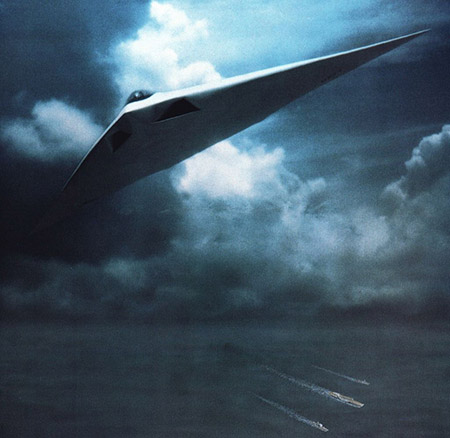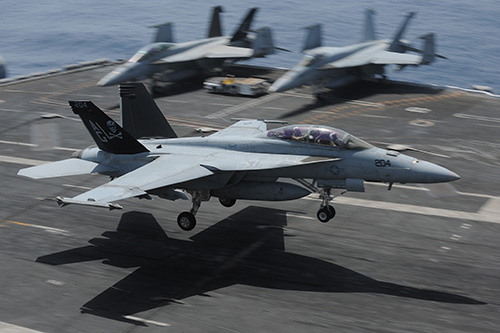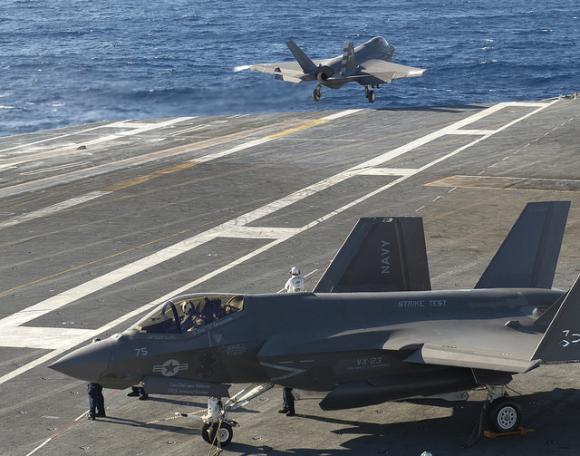"Perhaps it would be better to forget the billions invested in the F-35C and concentrate efforts to create murderous drones." This is what they suggest from Center for New American Security, a military think-tank held in high esteem by the Obama administration, in a new report published by former naval pilot Jerry Hendrix entitled "RETREAT FROM RANGE: The Rise and Fall of Carrier Aviation".
They write from the independent research institute "The F-35C will not be able to deal with modern threats. The progress made by the Chinese entail a new strategy that protects American aircraft carriers from long-range weapons. A carrier equipped with drones would be cheaper to manage and could strike at greater distances in safety. "
The American aircraft carriers are the symbol of the projection of US power in the world. Carriers can only operate in certain permissive contexts: practically everywhere shortly after the Cold War. The rise of new powers, including China (thought goes to career killer Dong Feng-21), require the Navy to operate at a safe distance. This means a limitation on the ability to project US power in the globe and a review of the American aeronaval strategy.
From World War II to the present, American carriers have been designed to support platforms capable of delivering a mortal blow against the nerve centers of the enemy. From Vietnam to Desert Storm, the US navy continued to refine its ability to hit the enemy in depth, embarking on aircraft carriers up to 80 multi-role aircraft (continuously modified over the years). The end of the cold war, however, is considered the breaking point. Platforms designed for deep penetration, such as the A-6 Intruder, are starting to come off the scene.
 The decision to also cancel the Intruder replacement, the A-12 Avenger II, is now considered one of the biggest mistakes in the history of the US navy. With the withdrawal of the service of the beloved Tomcat, a missile platform for the 'Phoenix', the navy began to embark the F / A-18 Hornets, originally designed as fighters for maneuvered combat and light attack.
The decision to also cancel the Intruder replacement, the A-12 Avenger II, is now considered one of the biggest mistakes in the history of the US navy. With the withdrawal of the service of the beloved Tomcat, a missile platform for the 'Phoenix', the navy began to embark the F / A-18 Hornets, originally designed as fighters for maneuvered combat and light attack.
Analyzing the projection capacity, it turns out that the most powerful navy in the world has gone from a radius of projection of 800 nautical miles in the 1996 to 500 in the 2006. Paradoxically, the reduction in US embarked projection coincided with the commissioning of the Chinese Anti-Access / Denial Area systems and with weapon systems with a range of more than one thousand nautical miles.
“Considering that our carriers have been rendered ineffective by the defensive systems in development, it would be appropriate to invest resources in the development of an automated platform, exploiting the know-how acquired with the X-47B. Greater autonomy, power, range and innovative weapons, combined with a long-range drone, would give American carriers supremacy even in the near future ".
"Such a plane would not be cheap. An unmanned embarked combat system could also cost 175 million dollars per specimen, but it could be the cheapest one. "
According to the specifications developed, the drone should have double (if not triple) the range of an F-35C, greater load capacity and resistance. Moreover, while the F-35C will spend its operational life in symbiosis with its human counterpart, the UCAS could be used only for combat operations and moved from one carrier to another without limitations.
"Six UCAS squadrons (90-110 aircraft), could replace all US fleet fighters. The cost savings for the entire duration of the UCAS program compared to that for the F-35C ranges from 54 to 170 billion dollars ".
the options
Option A - Two Super Hornet squadrons (24 aircraft), two Joint Strike Fighter squadrons (20 fighters) and one UCLASS squadron (six aircraft) could guarantee a normal transition to the sixth generation FA-XX between the 2025 and 2030. This option has the advantage of continuing the procurement plan envisaged for logistically implemented platforms. However, such an embarked force would not be large enough to cover the entire operational area and could not operate in a context with a powerful Anti-Access / Denial Area system.

Option B - The second option envisages the end of the F-35C program with massive use of the resources saved to reopen the line Super Hornet. The relatively low costs of managing the Hornets would guarantee the US navy to reform the entire flight line, without breaking the constraints of the current Defense budget. THE Super Hornet they would guarantee lower unit costs and greater stability before conversion to the sixth generation fighter.
The most powerful Navy in the world has 600 fighters F / A-18C Hornet and Super Hornet, but for 340 only of them is expected to be replaced with the new F-35C. As is known, the F-35C will not reach the initial operational capacity before the 2018 with production that will be at the rate of twenty aircraft per year from the 2020. However, another two years will be needed to reach the full capacity of the F-35C platform. From the planned six thousand flight hours, the Navy hopes, thanks to a service life extension program (SLEP), to bring at least 150 aircraft to an operating life of ten thousand hours (the maximum limit set by the Naval Air Systems Command). To date, considering the budget cuts, the Marina is under maintenance between the 65 and the 70 F / A-18C. The very high levels of stress to which the fighters are subjected, however, have highlighted worrying levels of corrosion on a greater number of fighters (we are always talking about platforms that operate at sea).
According to a recent estimate, more than one hundred Hornets would require urgent maintenance. Without forgetting that the "middle age extension" program for the Super Hornets has been expected for over a decade.
The "Dong Feng" class
The "Dong Feng" or "Vento dell'Est" class is made up of a series of medium and long range intercontinental ballistic carriers in service with the Chinese Missile Strategic Force.
The enemy number one of the US aircraft carriers is called DF-21D, a MARV multi-head anti-ship ballistic missile deemed capable of sinking an aircraft carrier. Already in the 2009, commenting on the system, the CIA said that "if it worked it would be absolutely capable of piercing every existing defense".
The missile version D of the "Dong Feng-21", flies to the 10 mach target. The only way to circumvent an attack carried out by an 10 mach missile whose exact launching point is lost would be through the use of electronic countermeasures.
The DF-21D exists, but we have no confirmation of its real capabilities. It should have a range of 2500 km and inertial guidance system with radar active in the terminal phase. We are certainly not in front of the classic Iranian rhetoric, with cardboard instruments sold for ultra-technological carriers: China is the future enemy for the US, but one wonders if it has the know-how necessary for such weapons, considering that there is no evidence of its use on a moving carrier. With the money needed to build an aircraft carrier, however, the Chinese could buy no less than 1200 missiles DF-21D.
The evolution of the DF-21D, the DF-26 would increase the radius of action to 3600 km, but of its entry into service there is no trace.
(photo: Lockheed Martin / Boeing / web)












